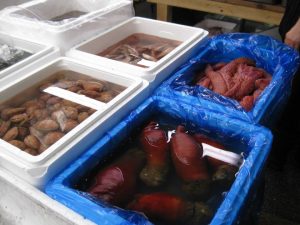
Salmon is a fish that has become very popular outside of Scandinavia in recent years. In recent years, Asia has become aware of how good the quality of salmon in Scandinavia is and part of the Scandinavian salmon ends up in, among other things Japan.
Denmark is the perfect spot when it comes to fresh salmon, which is suitable for cooking on a pan or eaten raw. Salmon arrives daily from Norway, Sweden and the Faroe Islands.
A few years ago, Faroese salmon that was farmed out in the sea only came to Denmark twice a week. That type of salmon is the most expensive and initially the demand was not that big. Since then, things have gone strong and Faroese salmon of high quality arrives in Denmark every single day.
On the Sushi course for beginners you learn more about which type of fish is best suited for sushi.
Read more about Sushi course for beginners
_
Zoë has lectured and held sushi courses for A. P. Moller – Maersk, Hugo Boss Nordic, Novo Nordisk, Novartis, Velux, Gorrissen Federspiel, Beierholm revision, Elbek & Vejrup and many more.





